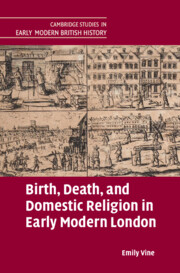Refine search
Actions for selected content:
89 results
5 - Elegy or The Rule of the Fathers: The Break with the Past
-
- Book:
- Tied Up in Tehran
- Published online:
- 28 September 2025
- Print publication:
- 16 October 2025, pp 92-110
-
- Chapter
- Export citation
Chapter 3 - Watery City
-
- Book:
- Maritime Relations
- Published online:
- 23 August 2025
- Print publication:
- 04 September 2025, pp 101-139
-
- Chapter
- Export citation
15 - Parkdale 2024
-
- Book:
- Dreams and Songs to Sing
- Published online:
- 07 August 2025
- Print publication:
- 07 August 2025, pp 296-304
-
- Chapter
- Export citation
Chapter 5 - Dying and Deathbed Practices
-
- Book:
- Birth, Death, and Domestic Religion in Early Modern London
- Published online:
- 17 July 2025
- Print publication:
- 31 July 2025, pp 159-188
-
- Chapter
- Export citation
Chapter 3 - Religious Practices Following Childbirth
-
- Book:
- Birth, Death, and Domestic Religion in Early Modern London
- Published online:
- 17 July 2025
- Print publication:
- 31 July 2025, pp 97-124
-
- Chapter
- Export citation
Chapter 6 - Domestic Religion in the Days After Death
-
- Book:
- Birth, Death, and Domestic Religion in Early Modern London
- Published online:
- 17 July 2025
- Print publication:
- 31 July 2025, pp 189-216
-
- Chapter
- Export citation
Chapter 2 - Childbirth, Religious Practice, and Domestic Space
-
- Book:
- Birth, Death, and Domestic Religion in Early Modern London
- Published online:
- 17 July 2025
- Print publication:
- 31 July 2025, pp 64-96
-
- Chapter
- Export citation
Chapter 1 - Domestic Religion in Seventeenth- and Eighteenth-Century London
-
- Book:
- Birth, Death, and Domestic Religion in Early Modern London
- Published online:
- 17 July 2025
- Print publication:
- 31 July 2025, pp 28-63
-
- Chapter
- Export citation
Chapter 4 - Daily Domestic Devotion and Preparation for Death
-
- Book:
- Birth, Death, and Domestic Religion in Early Modern London
- Published online:
- 17 July 2025
- Print publication:
- 31 July 2025, pp 125-158
-
- Chapter
- Export citation
Conclusion
-
- Book:
- Birth, Death, and Domestic Religion in Early Modern London
- Published online:
- 17 July 2025
- Print publication:
- 31 July 2025, pp 217-226
-
- Chapter
- Export citation
Introduction
-
- Book:
- Birth, Death, and Domestic Religion in Early Modern London
- Published online:
- 17 July 2025
- Print publication:
- 31 July 2025, pp 1-27
-
- Chapter
- Export citation

Birth, Death, and Domestic Religion in Early Modern London
-
- Published online:
- 17 July 2025
- Print publication:
- 31 July 2025
At home in the cloudberry marsh: on the making and remaking of Sámi home place landscapes
-
- Journal:
- Polar Record / Volume 61 / 2025
- Published online by Cambridge University Press:
- 12 March 2025, e10
-
- Article
-
- You have access
- Open access
- HTML
- Export citation
13 - Tax Havens, Commodified Citizenship, and the Production of Home in a Globalised World
-
-
- Book:
- Anthropology and Tax
- Published online:
- 12 December 2024
- Print publication:
- 19 December 2024, pp 304-325
-
- Chapter
-
- You have access
- Open access
- HTML
- Export citation
Jogendra’s properties in Noakhali: Displacement and the death of hope
-
- Journal:
- Modern Asian Studies / Volume 58 / Issue 6 / November 2024
- Published online by Cambridge University Press:
- 05 February 2025, pp. 1608-1637
- Print publication:
- November 2024
-
- Article
-
- You have access
- Open access
- HTML
- Export citation
Exploring the influence of context on social norms around Australian parents’ food provision using story completion
-
- Journal:
- Public Health Nutrition / Volume 27 / Issue 1 / 2024
- Published online by Cambridge University Press:
- 05 April 2024, e110
-
- Article
-
- You have access
- Open access
- HTML
- Export citation
Italian women workers and women activists between home and factory: the struggle against labour precarity (1950s–1970s)
-
- Journal:
- Modern Italy / Volume 29 / Issue 2 / May 2024
- Published online by Cambridge University Press:
- 18 March 2024, pp. 150-165
- Print publication:
- May 2024
-
- Article
-
- You have access
- Open access
- HTML
- Export citation
Chapter 10 - The RADx® Regulatory Core and Its Role in COVID-19 Emergency Use Authorizations
-
-
- Book:
- Accelerating Diagnostics in a Time of Crisis
- Published online:
- 06 January 2024
- Print publication:
- 07 March 2024, pp 194-210
-
- Chapter
- Export citation
The point of death: Religious conversion and the self in South India – CORRIGENDUM
-
- Journal:
- Modern Asian Studies / Volume 58 / Issue 1 / January 2024
- Published online by Cambridge University Press:
- 23 October 2023, p. 243
- Print publication:
- January 2024
-
- Article
-
- You have access
- Open access
- HTML
- Export citation
The point of death: Religious conversion and the self in South India
-
- Journal:
- Modern Asian Studies / Volume 58 / Issue 1 / January 2024
- Published online by Cambridge University Press:
- 25 September 2023, pp. 218-242
- Print publication:
- January 2024
-
- Article
-
- You have access
- Open access
- HTML
- Export citation
